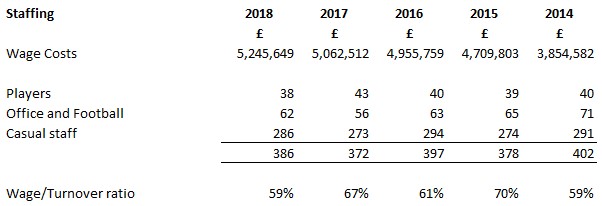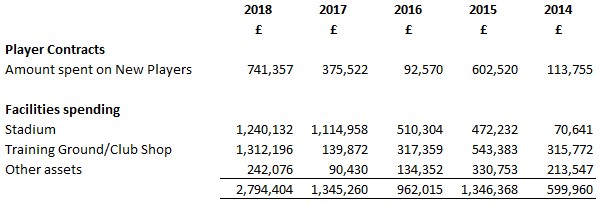It’s that time of year again when Pompey file their accounts. The latest set are for the 2017-18 season and, given this is the first year of Tornante ownership, we’re going to give a brief summary of the key metrics so that fans can understand how the finances of the club are shaping up.
The news article on the club’s official website includes a link to download the accounts here: https://www.portsmouthfc.co.uk/news/2019/march/statement-of-accounts/
The club has kindly provided us with advance sight of the accounts for preparing this article for which we are grateful
Profit and Loss Account
We’ll start with the Profit and Loss Account. This is the statement of the revenues the club generated and the costs it incurred during the year.
The revenues of the club continue to rise, reaching the highest level since the club was brought out of administration. In the table below you can see how the club’s income has grown over the last 5 years.

Ticket income has consistently grown as the attendances and season ticket sales have grown. If we take into account the fact that 2016 was a bumper year due to cup runs then we can see that 2018 was a good year for ticket income.
The income from the Football League and TV increased by 43% to £2.1m. This reflects the step up in money from League 2 to League 1. The difference in money at this level to the Championship is noticeable though with Championship clubs receiving at least £7m and Premier League Clubs receiving a minimum of £100m.
Wages
The biggest cost of any football club is the wage bill. Controlling wage costs is the most important factor for the long-term stability of a club, however squeezing it too tight can impact on the performance of the club on the pitch. It’s a difficult balancing act – funding a competitive playing team without spending beyond the club’s means.
During fan ownership, the club got this spot on and this has continued under Tornante.

We can see that the percentage of income spent on wages actually fell in 2017-18. This is perhaps understandable as the new owners get to grips with the reality of owning a football club. Additionally, in 2017 there were bonuses for the players for being promoted as Champions. I’m expecting to see that percentage rise a bit in future years particularly as the additional players add to costs.
Finally, we have the two measures of profitability – EBITDA and Net Profit.
EBITDA (Earnings Before Interest, Tax, Depreciation and Amortisation) is the measure of whether the club generated enough income to cover its normal operating costs – ie, the wages, administrative costs, etc.
Net Profit is the total profit or loss taking the EBITDA figure and then subtracting depreciation on the stadium and other assets as well as the writing off of player contracts. When a player is signed the cost of that signing is spread out (written off or amortised in accounting language) over the length of the player’s contract. So, for example, if we sign a player for £300k and give him a 3 year contract then the amortisation cost is £100k per year.
Under fan ownership, we were often prepared to fund losses caused by non-cash costs such as asset depreciation and player contract amortisation but there was limited ability to fund losses caused by spending more than the club earned.

Here we can see one big change from fan ownership to the new model. The investment of £10m made by Tornante when buying the club has enabled it to fund a higher level of spending not just on players but also on other day to day costs. Additionally, there were costs that arose during the sale of the club and significant sums have been spent on architects and other costs in looking at the future development of the stadium.
Balance Sheet
Next, we turn to the Balance Sheet. This shows the value of all of the assets that the club owns, any monies that are owed to the club and also the money it owes other clubs, banks or creditors.
Looking first at the assets of the club, in particular the spending on players and on improving the stadium, and other facilities.

What we can see here is that £2.8m was spent last year improving the stadium, the training ground and club shop as well as other parts of the club. Additionally, £742k was spent on transfer and agents’ fees. It is pleasing to see that the commitments made during the takeover are being honoured with investment in the facilities of the club.
Next, we look at the monies owed to the club, or Debtors as they are called in the accounts. These are largely unchanged from past years with one major exception.
As we know, Tornante invested £10m into the club on takeover. During the 2017-18 season, £7m of this was transferred back to the US parent company of PFC and is shown as being owed back to the club at the end of the year.
At first glance this gave some cause for concern and therefore we asked for some clarification from the club on the reasons for this and the intentions for this money in the future.
The club have informed us that of the £10m new funds received from Tornante; £3m was required to fund operations and new investment in stadium and infrastructure. Therefore; with £3.3m at bank at the year-end with new season ticket sales; £7m was transferred back to the owners high interest-bearing account to optimise funds for the club. There are no conditions to drawing down these funds which are expected to be fully spent on future stadium works.
Finally, on the Balance Sheet we look at the monies owed by the club, or Creditors as they are called in the accounts.
It is good to be able to confirm that the club remains debt free. Although there are some large amounts shown as creditors, these relate to technical accounting adjustments due to money paid to the club that relates to future seasons. For example, the season ticket money received up to 30 June 2018 relates to the following season. Therefore, this is technically owed to the season ticket holders until the next season starts, but obviously in reality does not get repaid.
Summary
Overall the accounts for 2017-18 reflect continued progress by the club. The sustainable model of operations has carried on, and the new owners have resisted the temptation to throw large amounts of money at the playing budget.
A significant investment has been made in the facilities of the club as was promised, and there are still £7m of funds available for further investment. Although the return of that £7m to the owners may cause some concern with fans, we have no reason to doubt the explanation from the club.
Works carried out since June 2018, including the current works on the South Stand cladding and roof would likely require drawing from those funds and there have been other potential works mooted in interviews that would easily require it all to be drawn down, therefore I am not concerned about this at the present time.
Looking further ahead, the PST will continue to work with the club to understand the future funding model, especially once the initial £10m invested runs out. Sustainability is important to the PST and the wider fanbase. We’ve had good feedback from Mark Catlin, Tony Brown, Andy Redman at Tornante and the Eisner family to reassure us that they share this view of how the club should operate for the long-term future.
There will be challenges ahead, particularly if we get promoted this season. The Championship is a very difficult league. There are wide variations in revenue from clubs with smaller stadiums and no parachute money reaching maybe £15m revenue, and other clubs with big stadiums and parachute money getting £70m+ in revenues. Hopefully it’s a challenge that we’ll be engaging with the club about this summer.
Simon Colebrook
Chairman
Pompey Supporters’ Trust